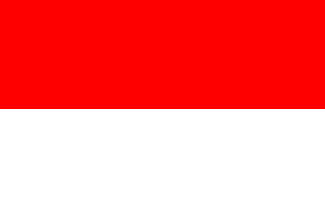





 The Air Force of the Republic of Indonesia (formerly AURI, currently TNI Angkatan Udara), like the navy, was also established as a separate service in 1946 and evolved from the aviation division of the People's Security Forces (BKR). When it became a separate service, the air force had only a few pilots. Nevertheless, it assumed responsibility for the air defense of the republic and took over all existing Dutch airfields and equipment. Initially, the air force was fairly small and flew mostly United States- and West Europeanorigin aircraft. However, between 1958 and 1964, the force expanded rapidly and switched to Soviet-bloc aircraft, purchasing more than 100 MiG-17 fighters, Il-28 bombers, and other aircraft from Soviet and East European sources. Personnel strength doubled. By the early 1960s, the Indonesian air force was the best equipped air arm in Southeast Asia.
The influence and capability of the air force fell sharply after the 1965 attempted coup. The air force was heavily purged for its role in the events associated with the coup attempt, and the abrupt turn away from the Soviet bloc ended the significant flow of equipment and logistics support that had been the key to expansion during the early 1960s. The air force's large armada of Soviet aircraft subsequently fell into disuse and disrepair. At the same time, the sharp drop in defense expenditures initiated under Suharto, and the anticommunist orientation of the New Order government, prevented the purchase of needed spare parts and maintenance assistance and led to the rapid grounding of almost all East European-made equipment. Significant modernization did not get under way until the late 1970s with acquisition of the F5 and A-4 aircraft from the United States.
The Air Force of the Republic of Indonesia (formerly AURI, currently TNI Angkatan Udara), like the navy, was also established as a separate service in 1946 and evolved from the aviation division of the People's Security Forces (BKR). When it became a separate service, the air force had only a few pilots. Nevertheless, it assumed responsibility for the air defense of the republic and took over all existing Dutch airfields and equipment. Initially, the air force was fairly small and flew mostly United States- and West Europeanorigin aircraft. However, between 1958 and 1964, the force expanded rapidly and switched to Soviet-bloc aircraft, purchasing more than 100 MiG-17 fighters, Il-28 bombers, and other aircraft from Soviet and East European sources. Personnel strength doubled. By the early 1960s, the Indonesian air force was the best equipped air arm in Southeast Asia.
The influence and capability of the air force fell sharply after the 1965 attempted coup. The air force was heavily purged for its role in the events associated with the coup attempt, and the abrupt turn away from the Soviet bloc ended the significant flow of equipment and logistics support that had been the key to expansion during the early 1960s. The air force's large armada of Soviet aircraft subsequently fell into disuse and disrepair. At the same time, the sharp drop in defense expenditures initiated under Suharto, and the anticommunist orientation of the New Order government, prevented the purchase of needed spare parts and maintenance assistance and led to the rapid grounding of almost all East European-made equipment. Significant modernization did not get under way until the late 1970s with acquisition of the F5 and A-4 aircraft from the United States.
![[PDF]](id05_04d.gif)
The 1985 reorganization of the military made significant changes in the former territorial commands of the air force, which were eliminated from the structure altogether, with the service represented on the KODAM staff by a senior liaison officer. The air force territorial commands were replaced by two Operations Commands (KO-OPS). The Air Force KO-OPS split with KO-OPS I corresponding to KODAMs I through IV and VI and with KO-OPS II corresponding to KODAM V and KODAMs VII through IX. The air force's National Air Defense Command (KOHANUDNA) remained under the ABRI commander in chief. It had an essentially defensive function that included responsibility for the early warning system.
In 1992 air force strength was about 27,000. Approximately 4,000 of these personnel formed four battalions of "quick action" paratroopers. The structure of the air force consisted of a headquarters staff in Jakarta supporting the chief of staff, two subordinate commands (Air Mat�riel Command and Air Training Command), and three operational commands (Ko-Op I, Ko-Op II, and the National Air Defense Command). The Air Mat�riel Command was headquartered in Bandung, Jawa Barat Province, and the Air Training Command was in Surabaya, Jawa Timur Province. Indonesia's air operations were divided into two area commands with Jakarta being the east/west dividing point. The largest of the operational commands was Ko-Op II, headquartered in Ujungpandang, Sulawesi Selatan Province, and responsible for all air force operations east of Jakarta (including Kalimantan). KoOp I, headquartered in Jakarta, covered air force operations west of Jakarta. The National Air Defense Command, also headquartered in Jakarta, had operational control over all fighter and counterinsurgency aircraft.
